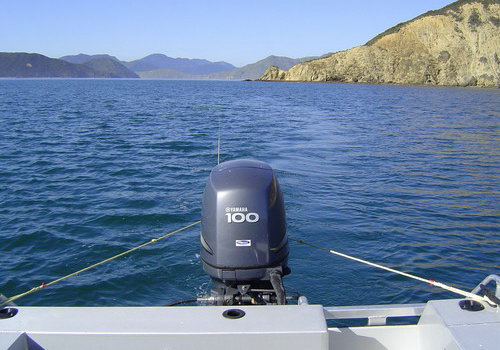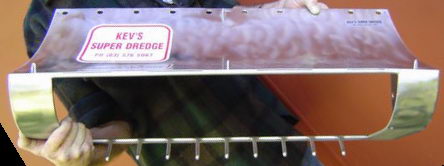|
|
Beds in shallow water tend to have waved floors and dredges of lighter construction tend to jump from sand wave top to wave top leaving a lot of scallops in their wake. My solution to this was to develop a fork tine bar fitted to the back of the dredge head. I also fit four yoke chains to the face plates rather than three on most dredges. This gives the face plate more support and allows a higher tow speed which in turn creates more down force driving the tine bar under the and waves and scallops. Another spin-off from this modification is a dredge that catches good numbers of dredge Oysters. By the late 1980s I was satisfied with the configuration of my dredge design - now days I have some parts computer laser cut making each dredge identical. In the early 1990s the scallop beds in Tasman Bay were very healthy and we were getting around 300 legal sized scallops with a five minute tow. At that time a friend asked me to build him a dredge but as he had just had major heart surgery I was concerned about him having to pull up a dredge full of scallops from 30m of water depth. This situation got me going again – Hydrofoil dredges self surface when towed in the opposite direction to the main tow but immediately sink when the power is taken off. I thought what is the point in self surfacing if the dredge does not stay on the surface? To fix this problem I designed and built a device that is fitted to the front of the yoke chains on all of my dredges and named it the Lift/N/Hold device. Once you have your dredge on the way up or on the surface on the reverse tow you shoot a carabina clip roped to a float down the tow rope. One the carabina has passed over the lift/N/Hold device and the float over the dredge head you back off the power and the dredge is trapped on the surface. This not only makes scallop dredging a lot less physically demanding but more importantly makes recovering your dredge a lot safer and while the Lift/N/Hold was originally invented to help out a mate it is now an integral part of all of my dredges. I now manufacture all my dredges in stainless steel and finish them off with a nice polished surface. Another thing I have done is mount the nets without lashing cord. The dredge head has twenty eight holes over under and sides and the net loops are fed through these holes and held in place by stainless steel needles. This makes it very quick and easy to replace nets when required. Because my dredges are going all over the country including the Chatham Islands and are being used on all types of vessels I have been able to develop different systems to suit my customers needs. One thing we have found to be very important is the rope used to tow the dredge. Rope diameter is very important and I recommend 8mm Donaghy's main line which has a breaking strain of around 1200kg – lighter rope will not have the strength required and heavier rope will create too much drag in the water, arcing and putting the dredge head out of line with the sea floor. Rope diameter is particularly important on deeper scallop beds. Rope length is also very important and I recommend a minimum four to one ratio e.g. for 20m of water depth you should have 80m of rope out. The rope I have recommended is fine for all vessels however if you are in a vessel over six metres long the weight factor must be allowed for. |
||
|
Copyright © 2003/2004 Kev's Super Dredge® |


